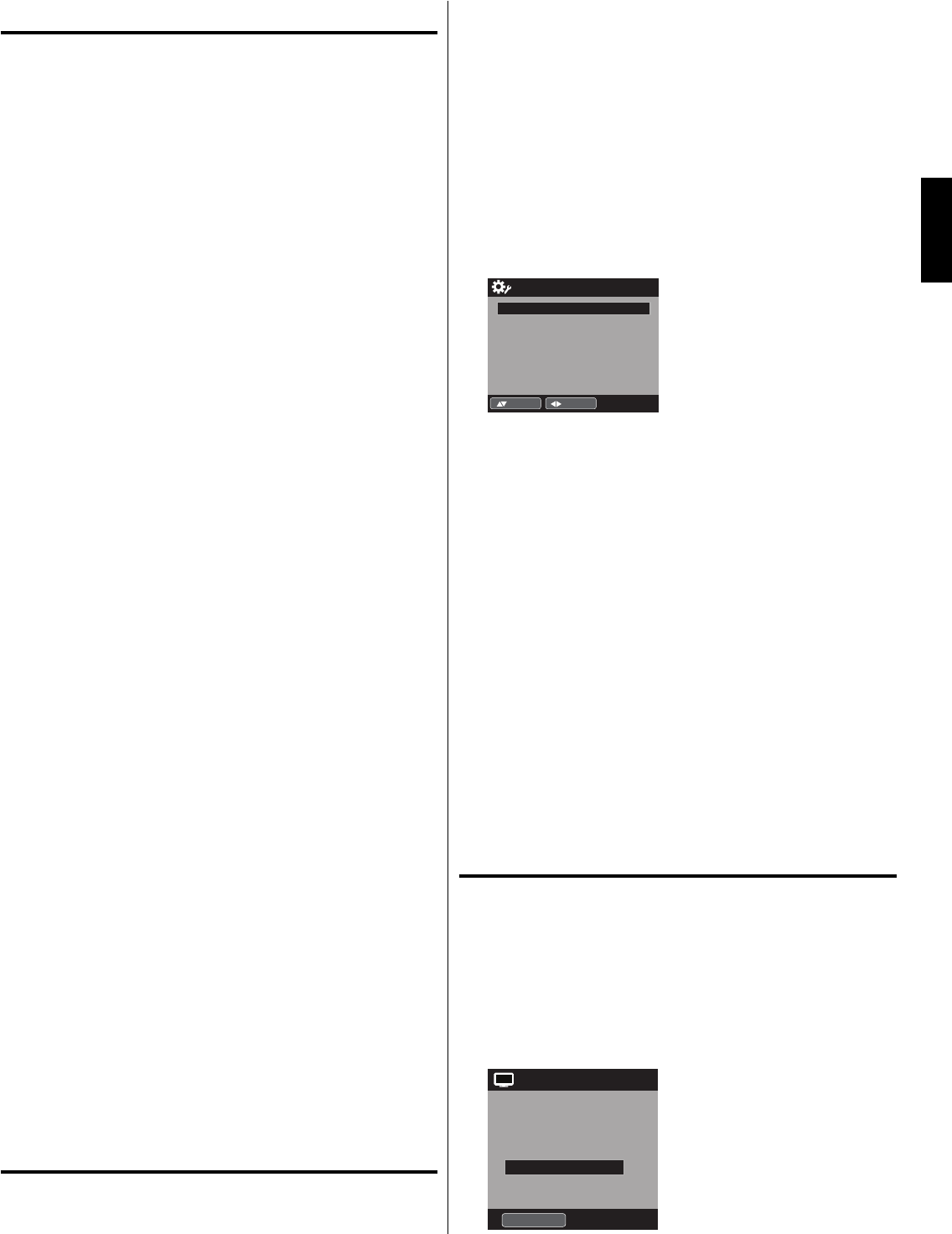
19
ENGLISH
Closed Caption
WHAT IS CLOSED CAPTIONING?
This television has the capability to decode and display Closed
Captioned television programs. Closed Captioning will display
text on the screen for hearing impaired viewers.
Captions: This Closed Caption Mode will display text on the
screen in English or another language if program supports other
languages. Generally, Closed Captions in English are transmitted
on CC1 and a Closed Caption in other languages is transmitted
on CC2.
Text: The Text Closed Caption Mode will usually fill 1/2 of the
screen with other text information such as weather if program
supports this feature.
1
Select “Setup”, then press ▶ or ENTER.
2
Press ▲ or ▼ to select “Closed Captions”, then press ▶ or
ENTER.
The Closed Captions menu will appear.
3
Press ◀ or ▶ to set “CC Display” to “On”.
On: Captions will be displayed on the screen.
Off: Captions will not be displayed on the screen.
4
Press ▲ or ▼ to select “Analog Caption” or “Digital Caption”.
When you select “Analog Caption”, you can choose from CC1,
CC2, CC3, CC4, Text1, Text2, Text3 and Text4.
When you select “Digital Caption”, you can choose from
Service1, Service2, Service3, Service4, Service5 and Service6.
5
Press ◀ or ▶ to select the desired Closed
Caption mode for
both Digital and Analog Caption.
6
Press ▲ or ▼ to select “CC Priority”, then press ◀ or ▶ to
select “Digital CC” or “Analog CC”.
NOTE:
Depending on the broadcast signal, some Analog Captions
will function with a Digital broadcast signal. This step
prevents that two kind of captions are overlapping.
•
NOTE:
If the program or video you selected is not closed-captioned, no
captions will display on-screen.
If text is not available in your viewing area, a black rectangle
may appear on-screen. If this happens, set the CC Display to
“Off”.
When selecting Closed Captions, the captioning will be delayed
approx. 10 seconds.
If no caption signal is received, no captions will appear, but the
television will remain in the Caption Mode.
Misspellings or unusual characters may occasionally appear
during Closed Captioning.
This is normal with Closed Captioning, especially with live
programs. This is because during live programs, captions are
also entered live. These transmissions do not allow time for
editing.
When Captions are being displayed, on-screen displays, such
as volume and mute may be seen but may interfere with Closed
Captions.
Some cable systems and copy protection systems may
interfere with the Closed Captioned signal.
If using an indoor antenna or if TV reception is very poor, the
Closed Caption Decoder may not appear or may appear with
strange characters or misspelled words. In this case, adjust the
antenna for better reception or use an outdoor antenna.
Closed Captions menu also can be displayed by pressing C.C.
on the remote control.
CC advanced
When you have selected Custom as the display method,
you can adjust the various setting listed below as follows:
This feature is designed to customize Digital Captions only.
•
•
•
•
•
•
•
•
•
1
Select “Setup”, then press ▶ or ENTER.
2
Press ▲ or ▼ to select “Closed Captions”, then press ▶ or
ENTER.
The Closed Captions menu will appear.
3
Press ◀ or ▶ to set “CC Display” to “On”.
4
Press ▲ or ▼ to select “Digital CC Preset”, then press ◀ or ▶
to select “Custom”.
5
Press ▲ or ▼ to select “CC Advanced”, then press ▶ or
ENTER.
The CC Advanced menu will appear.
6
Press ▲ or ▼ to select the desired item, then press ◀ or ▶ to
change the setting.
CC Advanced
Text Size Auto
Text Type Auto
Text Edge Auto
Text Color Auto
Text Opacity Auto
Background Color Auto
Background Opacity Auto
:Adjust
:Move
You can select from among the following items and
parameters.
Text Size: Auto, Small, Standard, Large
Text Type: Auto, Style1, Style2, Style3, Style4, Style5,
Style6, Style7
Text Edge: Auto, None, Raised, Depressed, Uniform, Left
Shadow, Right Shadow
Text Color: Auto, Black, White, Red, Green, Blue, Yellow,
Magenta, Cyan
Text Opacity: Auto, Solid, Transparent, Translucent,
Flashing
Background
Color:
Auto, Black, White, Red, Green, Blue, Yellow,
Magenta, Cyan
Background
Opacity:
Auto, Solid, Transparent, Translucent,
Flashing
NOTE:
You cannot set both “Text Color” and “Background Color” as a
same color.
You cannot set both “Text Opacity” and “Background Opacity” to
“Transparent”.
Aspect Switching
You can display the image at its optimum condition by
selecting display aspect.
Selecting the picture format aspect ratio
1
Select “Video”, then press ▶ or ENTER.
2
Press ▲ or ▼ to select “Aspect”, then press ▶ or ENTER
to display Aspect. Press ▲ or ▼ or corresponding Number
buttons (0-4)
to select the desired picture format aspect ratio,
as described below.
Aspect
1.Cinema Wide1
2.Cinema Wide2
0.Natural
4.Full
3.Cinema Wide3
[0-4] :Select
•
•
3FV1021A_eng.indd 193FV1021A_eng.indd 19 3/14/11 10:22:07 AM3/14/11 10:22:07 AM
